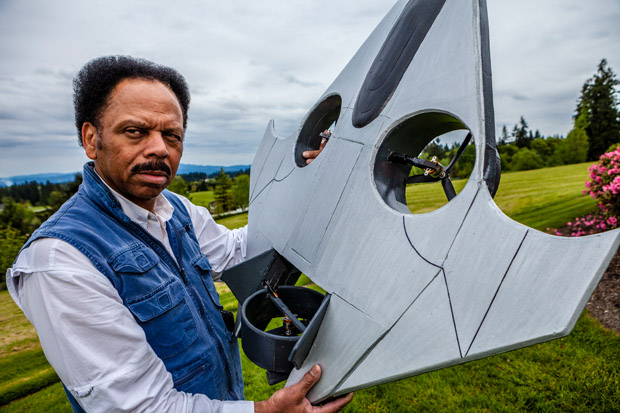BY ANNIE ELLISON
Portland tech veteran Ben Berry is leaving his post as Portland’s chief technology officer for a full-time role producing unmanned aerial vehicles (UAVs) aimed at first responders and the military. Berry’s AirShip Technologies Group is poised to be on the ground floor of an industry that will supply drones to as many as 100,000 police, fire and emergency agencies nationwide. He reveals the plan for takeoff.
BY ANNIE ELLISON
Portland tech veteran Ben Berry is leaving his post as Portland’s chief technology officer for a full-time role producing unmanned aerial vehicles (UAVs) aimed at first responders and the military. Berry’s AirShip Technologies Group is poised to be on the ground floor of an industry that will supply drones to as many as 100,000 police, fire and emergency agencies nationwide.
He reveals the plan for takeoff.

Greening aviation
We design small, clean-tech UAVs, and the reason we do that is today’s market has UAVs that last 30 minutes to about four hours. They don’t really have long flight endurance, so we had to do something different. That’s when we applied solar film to the exterior of the aircraft so we can fly all day long with solar, and then, to get night flight, we used a hydrogen fuel cell.
The right time
We’re at the very beginning of this market. Today it’s an $11.3 billion market. It’s going to go to $94 billion in two years.
Foresight
The FAA is just now opening up their rule set for commercial UAVs, but in September they’ll open up their rule set for first-responder UAVs. I saw the handwriting on the wall for this about two and a half years ago, when I developed the flying prototype and got a team around that. First responders are the ultimate target.
What’s for sale
We have seven different versions of the AirShip. We’re only looking at small ones right now — the V1, V2 and V5 [models]. The V1 is 16 inches by 16 inches, the V2 is about 3 feet by 3 feet, and the V5 is 6 feet by 6 feet. We’ll get to the much larger UAVs in the future, but probably after I sell off the business of small UAVs.
Ready for takeoff
So far we are preparing to go into production with AirShip, so we have 344 preorders, V2s and V5s, and we got our first 50 preorders with V1s. We’ve met with very good success in the marketplace in terms of people being receptive to the model, because there’s not a model out there that’s like it. We suspect we will carve out our particular niche in clean-tech UAVs into the military space as well.
Not your father’s drones
| The Federal Aviation Administration estimates as many as 7,500 small commercial unmanned aerial vehicles, commonly known as drones, may be in use nationwide by 2018. The number may change when the agency publishes the proposed rule on small, unmanned systems later this year. |
The V1 [model] is anywhere from about $10,000 up to about $17,000, which is the 16 inches by 16 inches. [The] V2 is about $30,000 to $45,0000. The V5 is anywhere from $100,000 to $149,000.
The big one
We’re working with Verizon right now for an emergency communications relay, to be able to fly drones that will pick up the signal from a laptop-size ground station that communicates with a satellite. That ground station pushes that signal back up to a UAV, and the UAV provides for x number of simultaneous Wi-Fi connections, principally for first responders.
Farewell to all that
May 1, I leave the city. I’ve really enjoyed working at the city, but this is the year of the drone. And every time you turn the TV on or read the newspapers, you see something being written up about it, and it’s a great point in time to make the switch to a permanent role at AirShip.
Like father, like son
My father was a Tuskegee airman, from WWII. Even up until his passing about a year ago, when he wrote his book, Tuskegee Airmen to the Moon, Mars and Beyond, I would go on presentations with him. I learned focus, going after your passion in general and never giving up, because he never gave up in his life.
Diversifying tech
It has to do with people who are in positions of authority in I.T. who are minority, as in my own case, getting out and speaking to kids when they’re in their junior high schools, in their high schools, and in college. Because when they see someone who looks like them and sounds like them, then they get to think, “Well, maybe those jobs are for me.”
Banking on the FAA
If you look at the current rule set, you’re not allowed to fly around people. Well, with first responders, the reason they’re responding is usually around people. You’re not allowed to fly unless you have line of sight. Well, first responders, think about search and rescue; think about aircraft lost at sea.
Multimillion-dollar baby
I have funded AirShip myself over these two and a half years, and originally it was a sole proprietorship. And so when I created a C Corp for AirShip, I moved all the patent work into AirShip. I moved in the aeronautical engineering design documentation, all the prototype work documentation. So that totaled to about $4.3 million in terms of value.
Get set. Go public
We currently have 5,000 shares for AirShip. Principally, I own those shares, but we’ve sent an application to Delaware Corporation operating in Oregon to move those shares to 100 million shares of common stock, and 2.5 million shares of preferred stock.
{jcomments on}

